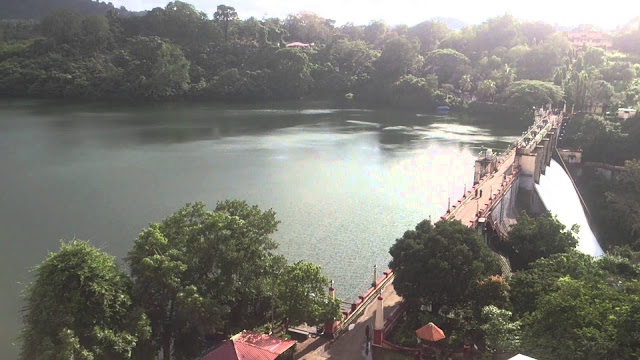CHEER UPP ....SEE THE BEAUTY OF KOLLAM......
KOLLAM
Kollam or Quilon (Coulão), CHEER UPP ....SEE THE BEAUTY OF KOLLAM......formerly Desinganadu, is an old seaport and city on the Laccadive Sea coast in Kerala, India on Ashtamudi Lake. Kollam has had a strong commercial reputation since the days of the Phoenicians and Romans. Fed by the Chinese trade, it was mentioned by Ibn Battuta in the 14th century as one of the five Indian ports he had seen during the course of his twenty-four year travels. Desinganadu's rajas exchanged embassies with Chinese rulers while there was a flourishing Chinese settlement at Kollam. In the 9th Century, on his way to Canton, China, Persian merchant Sulaiman al-Tajir found Kollam to be the only port in India visited by huge Chinese junks. Marco Polo, the great Venetian traveller, who was in Chinese service under Kublai Khan in 1275, visited Kollam and other towns on the west coast, in his capacity as a Chinese mandarin
V. Nagam Aiya in his Travancore State Manual records that in 822 AD two East Syrian bishops Mar Sabor and Mar Proth, settled in Quilon with their followers. Two years later the Malabar Era began (824 AD) and Quilon became the premier city of the Malabar region ahead of Travancore and Cochin. Kollam Port was founded by Mar Sabor at Thangasseri in 825 as an alternative to reopening the inland sea port of Kore-ke-ni Kollam near Backare (Thevalakara), which was also known as Nelcynda and Tyndis to the Romans and Greeks and as Thondi to the Tamils.
IMPORTANT INTRESTING PLACES TO BE VISITED IN KOLLAM........
THENMALA
CHADAYAMANGALAM
Chadayamangalam is one of the most tourist attracted village located in the Kollam district of southern India; in "God's Own Country" Kerala. The place is named after 'Nedila Paranthaka Nedumchadayan' who ruled Chadayamangalam the nearby places during 7th century AD.JADAYU PARA is situated in chadayamangalam
Chadayamangalam" or "Jadayumangalam" is historically an important place. It is 43 km away from capital city TRIVANDRUM. It's a beautiful metropolis lying between Kilimanoor and Kottarakara, 14 km away from Kilimanoor and 21 km from Kottarakara. It is situated on the southeast side of Kottarakkara Taluk and this place is enriched with huge Black Rocks which attracts and fascinates everyone who looks upon them. Neighbouring towns are (Kadakkal) & (Ayoor) which is 8 km, 3 km from Chadayamangalam Junction. This is one of the large blocks in the district with an area of 249.03&nbs9696454654;km2. Paddy, coconut, rubber, tapioca, pepper, cashew nut, banana, areca nuts etc. are the major crops under cultivation in the block. Two industrial estate and five industrial co-operative institutions are functioning here. Population is of 22,213. Panchayat includes Chithra, Kadakkal, Chadayamangalam, Ittiva, Velinalloor, Elamadu & Nilamel.
NEENDAKARA
Neendakara is a village in Kollam district 9 km north of Kollam city in Kerala, India. It is Kollam district's intermediate fishing port. Neendakara is 30 km north of Paravur.
When Portuguese traders settled in Kollam (then Quilon) in the early 16th century, their ships passed through the Neenadakara bar, now the site of Neendakara Bridge, part of National Highway 47, which connects the village to Sakthikulangara across Ashtamudi Lake. In Malayalam, Neendakara means "a long bank".[
Palaruvi Falls
The Palaruvi Falls (Malayalam: പാലരുവി വെള്ളച്ചാട്ടം) is a waterfall located in Kollam district in the Indian state of Kerala. It is the 32nd highest waterfall in India.
Sasthamcotta Lake
Sasathamcotta Lake or Sasathamkotta Lake, also categorized as a wetland, is the largest fresh water lake in Kerala, a state of India on the south of the West Coast. The lake is named after the ancient Sastha temple (a pilgrimage centre) located on its bank. It meets the drinking water needs of half million people of the Quilon district and also provides fishing resources. The purity of the lake water for drinking use is attributed to the presence of large population of larva called cavaborus that consumes bacteria in the lake water The lake is a designated wetland of international importance under the Ramsar Convention since November 2002.
Ashtamudi Lake
Ashtamudi Lake (Ashtamudi Kayal), in the Kollam District of the Indian state of Kerala, is the most visited backwater and lake in the state. It possesses a unique wetland ecosystem and a large palm-shaped (also described as octopus-shaped) water body, second only in size to the Vembanad estuary ecosystem of the state. Ashtamudi means 'eight coned' (Ashta : 'eight'; mudi : 'coned') in the local Malayalam language. The name is indicative of the lake's topography with its multiple branches. The lake is also called the gateway to the backwaters of Kerala and is well known for its houseboat and backwater resorts.[1][2][3] Ashtamudi Wetland was included in the list of wetlands of international importance, as defined by the Ramsar Convention for the conservation and sustainable utilization of wetlands.[4]
Achankovil
The Achankovil is a river in Kerala, India, created towards the southern tip of the peninsula by the confluence of the Rishimala, Pasukidamettu, and Ramakkalteri Rivers. The Anchankovil enriches the Pathanamthitta district of Kerala state. It joins with the Pamba River at Veeyapuram, in the Alappuzha district of Kerala. Achankovil is also the name of the forest area, which is the catchment area for this river, and of a small town situated in the Achenkovil forest area. The Achankovil village is not easily accessible; however, it can be reached through forest routes.The river also passes through the village Vazhuvadi.
NATURE ..... BEAUTY...... COOL MINDS ........ FRESH WATER..... CLIKZZ........















We are urgently in need of KlDNEY donors for the sum of $500,000.00 USD,(3 CRORE INDIA RUPEES) All donors are to reply via Email for more details: Email: healthc976@gmail.com
ReplyDelete